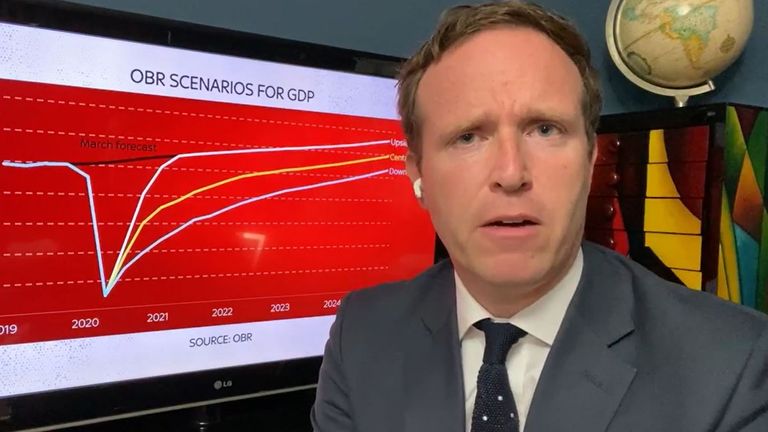Two weeks ago, America's largest banks gave an idea of how they are expecting to be hit by the pandemic, announcing a thumping $38bn worth of loan loss provisions.
This week, Europe's biggest lenders began signalling how they are preparing for the worst, with Barclays today raising its loan loss provisions to £3.7bn for the year to date and Deutsche Bank raising its loan loss provisions to €761m during April, May and June.
It meant that net losses at Germany's biggest lender almost doubled to €77m during the quarter.
Today's showstopper in Europe, though, was Santander - the continent's biggest bank, after HSBC, by stock market value.
The Spanish lender reported the first quarterly loss in its 163-year history - of €11.1bn - that reflected both loan impairments and a write-down in the value of some assets that came to €12bn.
Half of the latter relate to Santander UK - the business formed following the bank's £9bn takeover in 2004 of the old Abbey National and its later acquisitions, in the wake of the financial crisis, of Alliance & Leicester and the branch network and deposit book of Bradford & Bingley.
Santander had already written some €1.5bn from the value of Santander in September last year and today's move takes the total write-down to some €6.1bn.
The write-downs and loan loss provisions meant that, for the first half of 2020 as a whole, Santander reported a loss of €10.8bn.
Ana Botin, the executive chairman of Santander, said: "The past six months have been among the most challenging in our history. The impact of the pandemic has tested us all and I am proud of how Santander has responded."
She said that, during the second quarter, Santander lent an average of €1.6bn every day.
She added: "While our statutory profit reflects a non-cash revaluation of goodwill… due to the impact of the pandemic on the economic outlook, it has no impact on the group's balance sheet strength. The foundations of our business remain extremely strong, with capital at the top end of our target range."
A closer look at Santander's operations on a country by country basis, though, helps explain why it has written down the value of its UK business to the extent that it has.
During the first half of 2020, underlying profits at Santander UK were down by 76% on the same period last year - compared with falls of 64% in Spain itself, a 56% fall in the US, a 17% fall in Brazil - now the bank's single most profitable market - and an increase of 4% in Mexico.
Nathan Bostock, chief executive of Santander UK, insisted that results during the half-year had been "materially impacted" by COVID-19.
The bank reported loan impairments for the half year of £376m, up from £69m in the same period last year, while the emergency interest rate cuts by the Bank of England in March, which took Bank Rate from 0.75% to just 0.1%, clipped £129m from Santander UK's net interest income.
There is now a spread of just of 1.5% between what Santander UK typically charges borrowers and pays depositors - down from 1.69% in the same period a year ago.
Mr Bostock also had little good news about the outlook for the rest of the year. He said that, despite the significant support for the economy from the government and the Bank, the extent of the economic downturn and future recovery path remained "highly uncertain".
He said there was a further layer of uncertainty caused by a lack of clarity over the UK's future trading relationship with the EU.
Mr Bostock said that this meant the bank was looking at a number of economic scenarios that took in a "wide range" of possible outcomes, including a second COVID-19 wave and another lockdown, making it cautious in its outlook.
He added: "Our base case…assumes that the UK economy will experience a short, sharp recession in the first half of 2020 and a slow recovery for the rest of the year and into 2021, driven by the gradual easing of lockdown restrictions and a return to more normalised trading conditions."
He said that Santander UK, which is the UK's fourth-largest lender after Lloyds Banking Group/Halifax, Nationwide Building Society and the newly rechristened NatWest Group, had extended payment holidays to 239,000 customers whose £37.1bn worth of home loans represent just over a fifth of the bank's mortgage book.
Payment holidays were also extended to 28,000 customers with personal loans, 33,000 customers with car loans and 26,000 credit card customers.
The concern for all three of the European banks updating investors today - Barclays, Deutsche and Santander - is that the worst may be yet to come for many of their customers.
For Barclays and Santander UK, for example, the tapering of the furlough scheme and then its eventual winding-up in October is almost certain to result in further job losses.
Meanwhile, in Germany, the government's furlough scheme is due to come to an end in March next year.
The good news, such as it is, is that Europe's banking sector, like its American counterpart, entered the pandemic crisis better capitalised than it did the financial crisis.
That may be of little comfort, though, to shareholders both in Britain and on mainland Europe as both the Bank of England and the European Central Bank have ordered lenders not to pay any dividends this year.
That does not only hurt the big institutional investors. Barclays is still thought to have more than 500,000 retail shareholders, a legacy of its takeover of the old Woolwich 20 years ago, while Santander UK is estimated to have getting on for one million.
https://news.google.com/__i/rss/rd/articles/CBMidWh0dHBzOi8vbmV3cy5za3kuY29tL3N0b3J5L2Nvcm9uYXZpcnVzLWV1cm9wZXMtc2Vjb25kLWxhcmdlc3QtYmFuay1yZXBvcnRzLWhlZnR5LWxvc3Nlcy1vdmVyLXBhbmRlbWljLWltcGFjdC0xMjAzODcxMdIBeWh0dHBzOi8vbmV3cy5za3kuY29tL3N0b3J5L2FtcC9jb3JvbmF2aXJ1cy1ldXJvcGVzLXNlY29uZC1sYXJnZXN0LWJhbmstcmVwb3J0cy1oZWZ0eS1sb3NzZXMtb3Zlci1wYW5kZW1pYy1pbXBhY3QtMTIwMzg3MTE?oc=5
2020-07-29 18:46:41Z
52780961297222




Tidak ada komentar:
Posting Komentar